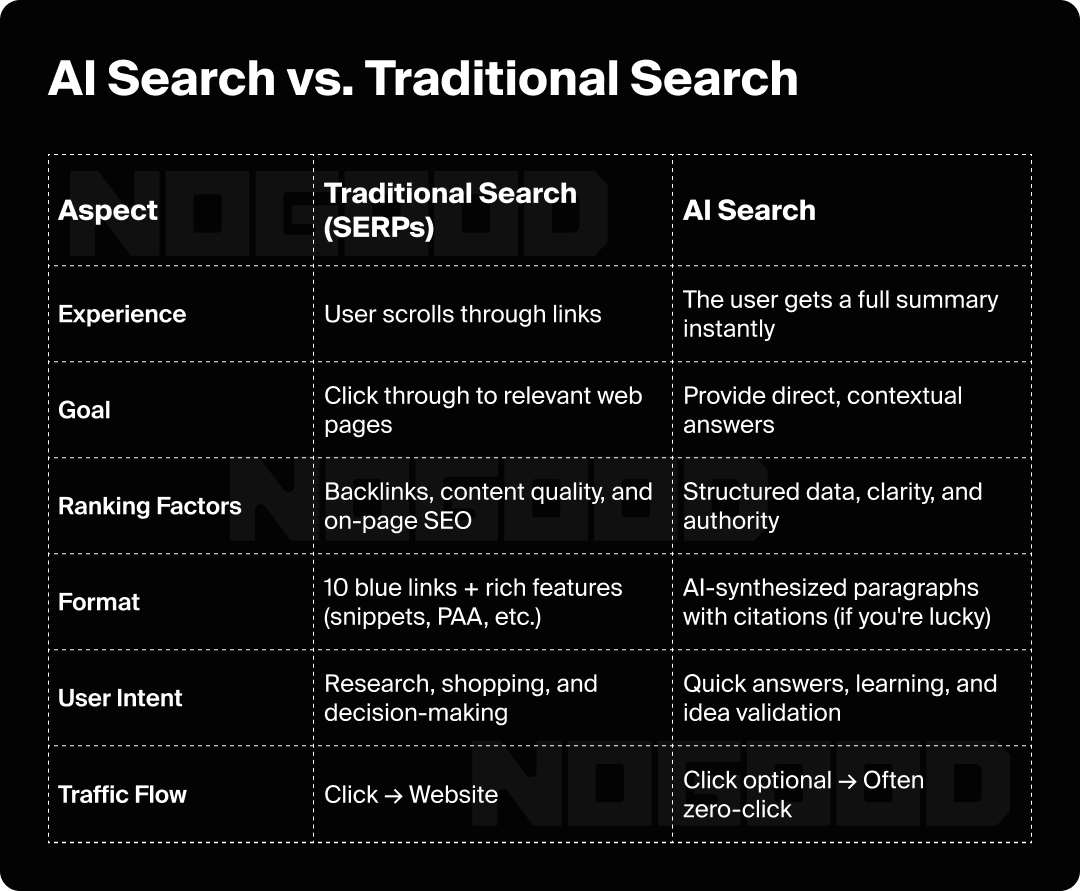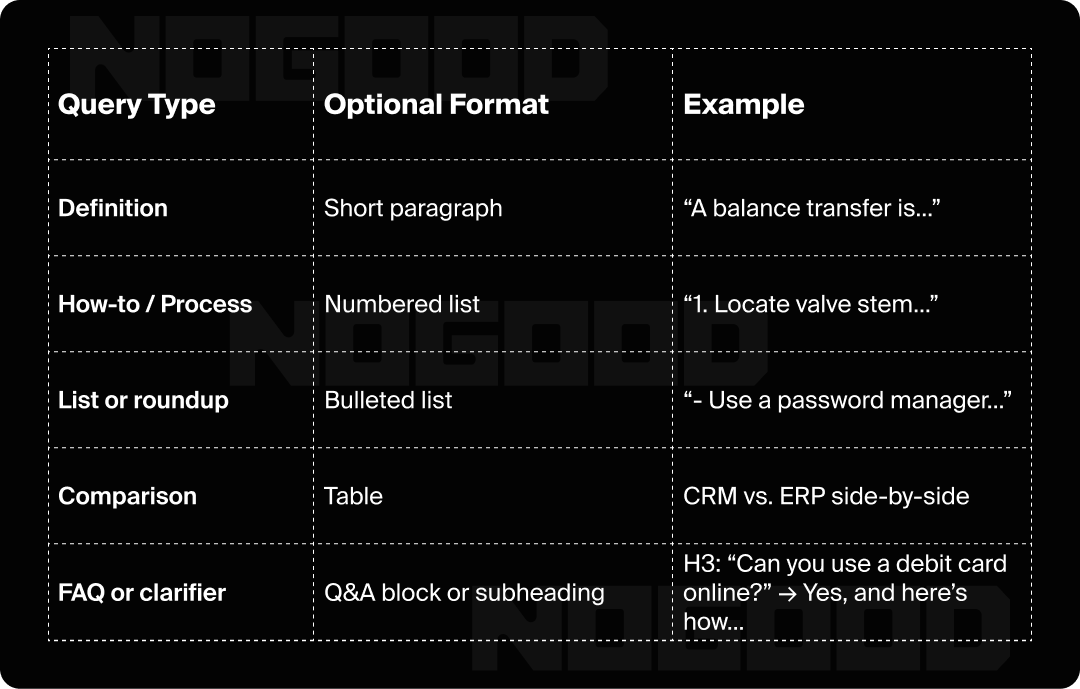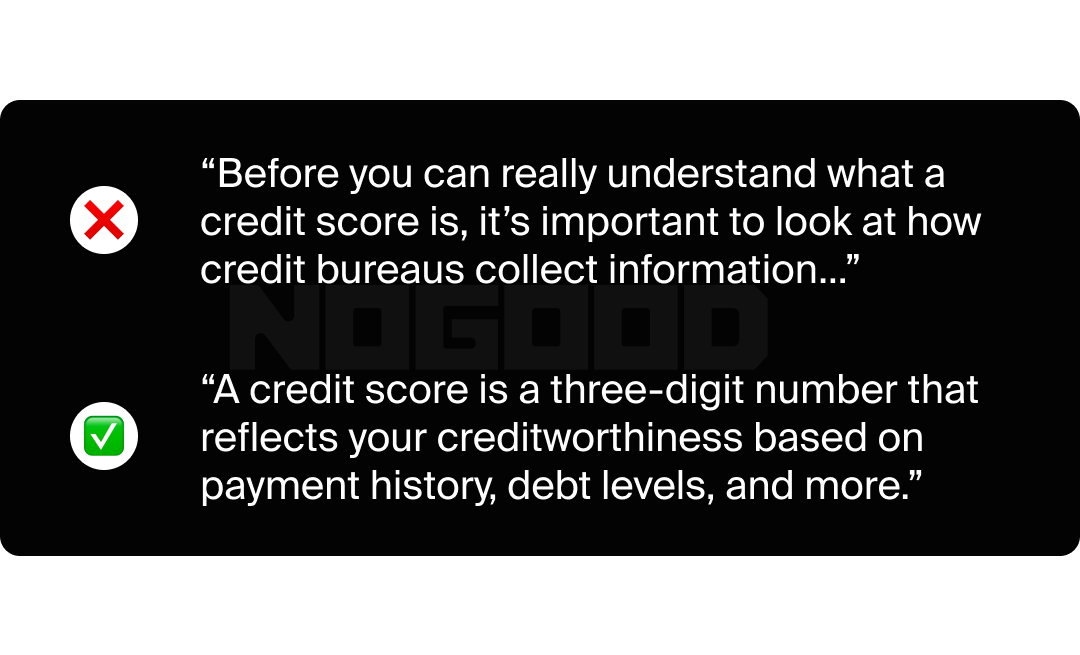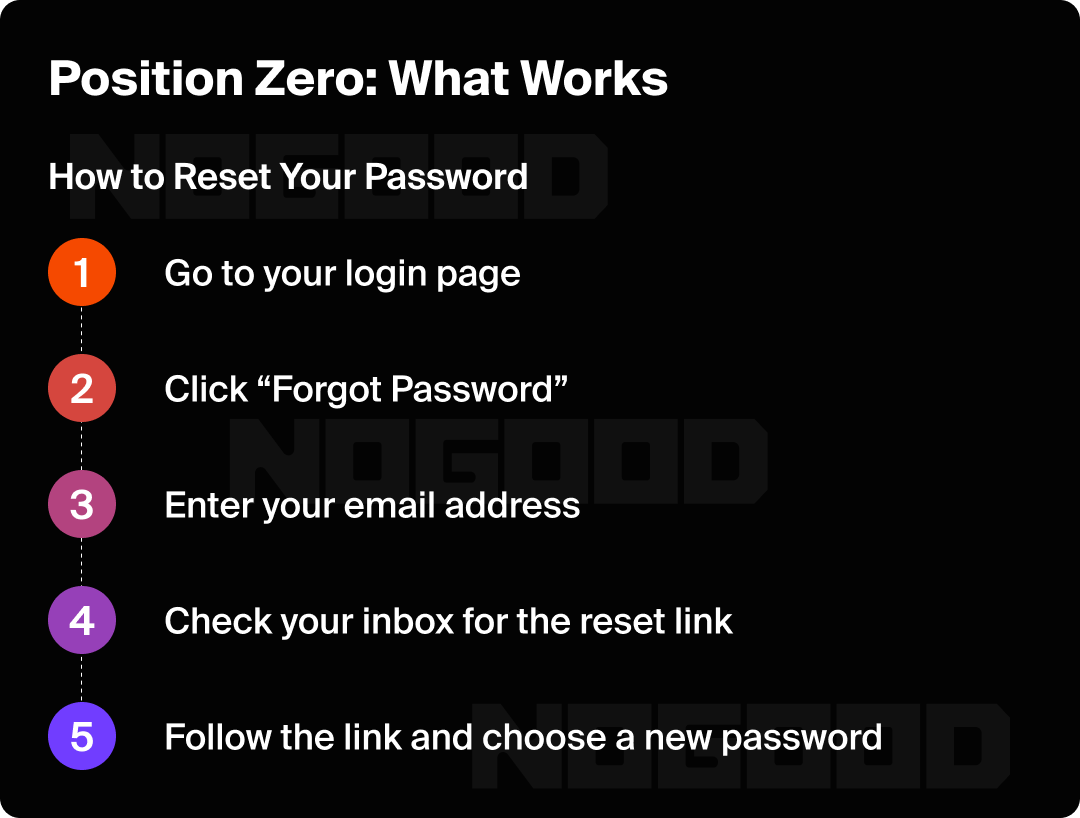SEO isn’t dead; it’s evolving. And at the center of that evolution? Position Zero.
Once a nice-to-have featured snippet, Position Zero is now the starting line for how people discover, trust, and engage with content across both traditional search engines and AI-powered tools like Google’s AI Overview, Gemini, ChatGPT, and Perplexity.
If you’ve noticed that your traffic looks different lately, or that your carefully optimized page is being paraphrased above the fold (without a click), you’re not imagining things. Welcome to the new search reality: where visibility isn’t just about ranking #1, it’s about being the answer.
In this guide, we’re diving deep into what Position Zero really is, how it works in both legacy and AI-powered search, and most importantly—how you can win it.
What Is Position Zero in SEO?
If you’ve ever Googled something like “how to tie a tie” or “what’s kombucha?” and gotten an instant answer right at the top of the page—before any blue links or ads—then you’ve seen Position Zero in action.
Position Zero is that boxed result sitting above the first organic listing. It’s Google’s way of saying, “Here’s the answer, no need to scroll.” It comes in two main forms today: the classic Featured Snippet and Google’s latest installment, the AI Overview (which started rolling out in 2024).
The content Google pulls for Position Zero can be a paragraph, a bulleted list, a numbered guide, or even a table, depending on the query. Definitions usually get paragraphs, step-by-step instructions get lists, comparisons get tables, and sometimes the internet’s chaos (also known as Reddit).
Here’s the kicker: Position Zero outranks Position One. You can be the top organic listing and still be second best if another page wins the snippet. Not only are you being outranked, your “Position One” listing might not even be in view for the user. Think of it as finishing second in a race where the winner got a head start.
Position Zero is no longer just a nice bonus—it now plays a key role in:
- Voice search (Alexa, Google Assistant, and friends love reading these aloud)
- Zero-click searches (users get their answers without clicking)
- AI Overviews (Google’s AI-generated summaries pull from snippet-worthy content)
In short, Position Zero isn’t just a shiny SEO trophy—it’s a direct path to visibility, credibility, and potentially better user engagement.
Why Position Zero Matters More Than Ever
Position Zero is more than prime real estate. It shapes how users find and trust your content. Here’s why it’s increasingly important:
- Better Visibility: Featured snippets sit above all organic results, grabbing attention and increasing brand awareness.
- Voice Search Influence: Voice assistants often pull answers from snippets, so optimizing for Position Zero helps reach voice search users.
- Zero-Click Searches Are Growing: More users get their answers directly on the results page. While clicks might drop, your brand still gains trust and exposure.
- Signals Authority & Trust: Google prefers content that’s clear, well-structured, and trustworthy. Landing Position Zero signals your content’s reliability.
- Stepping Stone to AI Search Inclusion: AI-powered tools often source content from Position Zero when generating answers, expanding your reach beyond traditional search.
AI Search vs. Traditional Search: What’s Changing?
For years, SEO was about climbing Google’s classic list of blue links. You optimized content, hoped for the best, and tried to snag that top spot.
Now, AI-powered search tools like Google’s AI Overview, Perplexity, ChatGPT’s web browsing, and Gemini change the game. Instead of showing a list of links, they generate summarized, conversational answers—sometimes citing sources, sometimes not—without necessarily driving traffic to your site.
Here’s a quick comparison:

The Role of AI & Generative Experiences in Position Zero
AI synthesizes info from multiple sources into conversational answers, it doesn’t just list links like the classic Google SERP we’re used to seeing. These AI summaries often pull from content that ranks in Position Zero or uses a similar structure.
That means optimizing for Position Zero also improves your chances of being referenced in AI-generated responses, giving you visibility beyond traditional search.
As generative AI grows, the content behind Position Zero snippets will increasingly shape how AI systems deliver answers. The focus isn’t just on ranking high—it’s on being the clearest, most trustworthy source.
Position Zero is quickly becoming a key part of how content gets discovered and reused in AI search. Understanding this connection helps you prepare for both current and emerging search landscapes.
So, What Does This Mean for Marketers?
Your content now competes for more than rankings—it’s competing to be the answer. Landing a featured snippet, getting cited by AI tools, or becoming the trusted source behind an AI response means your content has to be clear, well-structured, and credible.
We’re not trying to rank #1 and call it a day. We’re trying to be the answer that AI picks to show users.
To all of my fellow SEOs out there, don’t worry—AI search isn’t replacing SEO. Rather, it’s expanding it. We must now think beyond traditional SERPs and also focus on AI summaries and answers. It’s not one or the other—it’s both.
H-E‑E‑A‑T: The Trust Factor Behind Snippet Rankings
Google’s updated quality framework now emphasizes Helpfulness (H) alongside Experience, Expertise, Authoritativeness, and Trustworthiness—expanding on the familiar E.E.A.T. framework and forming H‑E‑E‑A‑T. Here’s what that means for earning Position Zero:
- Helpfulness (H): Your content needs to genuinely help users. That means clear answers, useful details, and no fluff. Snippet-worthy content quickly satisfies the search intent and satisfies Google’s helpfulness test
- Experience (E): Firsthand experience matters. Whether you’re detailing how to tie a tie or reviewing software, sharing personal insights or case studies gives your content more credibility than generic summaries.
- Expertise (E): Does the author know their stuff? Credentials, real-world qualifications, or insider knowledge signal to both users and algorithms that your content is high-quality.
- Authoritativeness (A): Are you a recognized source? Back that up with backlinks, mentions in industry publications, or being openly cited as a trusted voice.
- Trustworthiness (T): Always back claims with sources, keep information accurate, and be transparent about authorship or updates. This clarity builds trust and helps secure both snippets and AI citations.
Why It Matters
Google and AI systems want to serve content that’s useful and credible. H‑E‑E‑A‑T helps you:
- Create content that helps readers, which means fewer quick bounces and more engagement.
- Signal to Google (and AI models) that you’re not just repeating content, you own it.
- Build a foundation for consistent featured snippet wins and broaden your chances of being cited in AI Overviews.
What You Can Do Now
- Use author bios or credentials to showcase real expertise.
- Share personal examples, case studies, or data that demonstrate experience.
- Reference reputable sources and build genuine backlinks from trusted publications.
- Maintain your content so it’s always accurate and up-to-date.
How to Optimize Content for Position Zero
To earn Position Zero, you have to do more than “rank well.” You have to make it easy for search engines—and AI systems—to recognize your content as the answer. This isn’t about gimmicks or gaming the algorithm. It’s about clarity, structure, and genuinely helping users solve their problems faster than anyone else.
Here’s what actually works at landing your content at the top of the page in practice:
1. Understand Search Intent First, Keywords Second
Before you start writing (or optimizing), ask: What is the person behind this search actually trying to learn or do?
Position Zero is all about intent matching. If someone types in “how to change a flat tire,” they want steps—not a 2,000-word blog post about the history of rubber.
Think About:
- Is the query looking for a definition? → Include a clear paragraph.
- Are they trying to complete a task? → Write a step-by-step list.
- Are they comparing options? → Create a clean, scannable table.
Even the most optimized content won’t win Position Zero if it doesn’t match what users (and Google) are actually looking for.
How to do this well:
- Check the current featured snippet (if there is one)—what format is Google already rewarding?
- Use tools like AlsoAsked, Answer the Public, or even Google’s PAA boxes to see how people naturally ask about your topic.
2. Target Snippable Questions & Long-Tail Keywords
Google loves questions—and so do users—especially ones that can be answered quickly and clearly. After all, we have the term “Google it” for a reason.
Instead of optimizing for broad terms like “CRM tools,” zoom in on specific, snippable queries like:
- “What is a CRM tool?”
- “How to choose a CRM for small business”
- “CRM vs ERP: What’s the difference?”
These types of queries are not only more likely to trigger snippets—they’re also often easier to rank for and more aligned with AI Overviews.
Helpful Tip:
Format some of your subheadings as questions. This helps Google find Q&A-style structure in your content. And don’t be afraid to answer the question immediately after the H2/H3—Google loves a direct follow-up.
3. Format Your Answer to Match the Query Type
One of the most overlooked tactics is just formatting your content in the way Google already prefers.
Here’s what we mean:

Formatting isn’t just aesthetic. It tells Google what kind of answer you’re providing.
If your content is one dense blob of text, it’s much harder for Google (or Gemini, or Perplexity, or other LLMs) to extract a clean snippet from it.
4. Put the Answer First, Then Elaborate
One of the most common mistakes in blog writing? Burying the answer under intros, analogies, or scene-setting. Writer to writer, we know it’s fun to get creative and take our reader on a journey. But in practice—especially when SEO and AEO are at play—skip the fluff.
Position Zero rewards content that leads with the answer. Think inverted pyramid—give the TL;DR up top, then fill in the context afterward.
Example:

Then go into your longer explanation, examples, and nuance.
This is especially important for AI visibility, where the “pull quote” effect matters: if you give a clean, standalone answer, AI models are far more likely to grab it.
5. Structure Your Page with H2s, H3s & Scannable Sections
Position Zero doesn’t just come from the first paragraph. Google may pull from anywhere on the page—as long as the structure is clean.
Best practices:
- Use H2s for major sections and H3s for subpoints
- Include relevant keywords and queries in your headings
- Create mini-sections that could be featured on their own
- Keep paragraphs short—2-4 lines max
Pro move:
Use a navigable table of contents (especially for longer content). It improves usability and signals structure to search engines.
6. Use Lists, Tables & Visual Hierarchy to Your Advantage
Google likes content that’s easy to scan and categorize. So do users. If your content naturally lends itself to a:
- Checklist
- Step-by-step tutorial
- Product comparison
- Pros and cons list
…don’t bury that info in a paragraph—turn it into a list or table. Instead of saying “There are a few steps to resetting your password,” try:

7. Make Your Content Helpful (H‑E‑E‑A‑T-Optimized)
We’ve covered this in detail already, but it bears repeating: content that ranks in Position Zero tends to show Helpfulness, Experience, Expertise, Authoritativeness, and Trustworthiness.
So make sure your answer:
- Is factually correct and up-to-date
- Links to reputable sources
- Shows real-world knowledge or experience
- Is written by (or attributed to) someone credible
Bonus: Helpful content also increases your chances of being cited in AI summaries, not just snippets.
8. Optimize for Traditional SEO, Too (It Still Matters)
Position Zero isn’t detached from traditional SEO—it builds on it. You still need to conform to basic SEO best practices, like:
- Include the question and core keyword in your title tag
- Use a clean, descriptive URL (e.g. /how-to-tie-a-tie/)
- Write a meta description that reinforces the query
- Ensure fast load times, mobile responsiveness, and solid UX
- Use internal linking to connect related topics
Think of achieving Position Zero as doing everything that needs to be done from an SEO perspective, and then some—SEO is the foundation, and that additional optimization is your brickwork.
9. Use Schema Markup (Where It’s Actually Useful)
Schema won’t guarantee a featured snippet, but it can increase your chances — especially for content like:
- How-to guides
- FAQ pages
- Recipes
- Product comparisons
Using Schema.org or tools like RankMath, Yoast, or Merkle’s markup generator can help you embed structured data without diving into code manually.
10. Track Performance & Continuously Improve
Featured snippets aren’t permanent—as a matter of fact, no ranking position is. Google often rotates them, and rankings in general, based on freshness, phrasing, or competition. So treat your snippet strategy like a living system:
- Use Google Search Console to find what questions you already rank for
- Monitor click-through rate changes after earning a snippet
- Update content regularly to keep it accurate and competitive
- Expand on pages that are close—you might already be Position One, and one formatting tweak away from Position Zero
Bottom Line: Think Like a Search Engine & a Reader
Achieving Position Zero isn’t “gaming the system”—it’s creating genuinely helpful, well-structured content that makes it easy for both humans and machines to find answers.
If you:
- Understand intent
- Answer clearly and early
- Format for scanability
- Prove credibility
- Keep your content fresh
…you’re giving yourself the best shot at earning—and holding—that top spot.
What to Avoid When Aiming for Position Zero
Position Zero might seem like the SEO holy grail—but chasing it without a strategy can backfire. Not every page is meant to be a snippet, and not every “optimization” actually helps. If you’re aiming for that top spot, here are some common mistakes and missteps to avoid:
Burying the Answer
If your answer is halfway down the page, and behind a wall of fluff, you’re making Google (and your reader) work too hard.
What to Do Instead:
Put the most direct, snippet-worthy answer immediately after the question or heading. Think of it like writing for impatient people—because you are.
Overstuffing Keywords
You don’t need to include the phrase, “what is a marketing funnel” 12 times within 750 words to get a snippet. Over-optimizing makes content look robotic, and ironically, that makes it less appealing to both search engines and AI systems.
What to Do Instead:
Use natural language. Answer the question the way a helpful expert would. One or two well-placed mentions of the target phrase are more than enough.
Going Too Long—or Too Short
Some answers are too short to be useful—others are so long they never get considered for a snippet.
What to Do Instead:
Aim for the sweet spot: 40-60 words for paragraph snippets, or 4-8 bullets for list-based content. It’s not a hard rule, but it’s what tends to perform best.
Ignoring Formatting
You can have the best answer on the internet—but if it’s buried in a dense paragraph or unstructured layout, it probably won’t make the cut.
What to Do Instead:
Use subheadings, lists, tables, and visual hierarchy. Make your content easy to skim and easy to lift.
Targeting the Wrong Queries
Not every search triggers a featured snippet or AI Overview summary. Some queries are too vague or commercial to ever win Position Zero—and that’s okay.
What to Do Instead:
Focus on informational, question-based, or comparison queries that are actually eligible for snippets. Use tools like Ahrefs, Semrush, or even manual searches to confirm what types of results show up.
Ignoring Context & H-E-E-A-T
Being rewarded with a Featured Snippet doesn’t mean you “got the answer right”—you also have to show credibility. If your page looks thin, outdated, or lacks authority, it won’t be chosen as “the answer,” no matter how well it’s formatted.
What to Do Instead:
Demonstrate Helpfulness, Experience, Expertise, Authoritativeness, and Trustworthiness (aka H-E-E-A-T). Cite sources, highlight author credentials, and keep your content fresh.
Relying on AI Tools Alone
AI can help you generate outlines, identify related questions, and rephrase content—but it can’t replace human editing, strategy, or subject-matter expertise.
What to Do Instead:
Use AI as a support tool, not a substitute. Your content still needs real insight, clarity, and structure to compete for Position Zero.
The Bottom Line
Winning Position Zero doesn’t mean you’ve successfully “tricked” Google—it means you’ve helped the reader faster and better than anyone else. If you focus too much on “optimizing” and not enough on answering, you’ll end up missing both your reader and the algorithm.
Avoid shortcuts. Stay useful. And make your answer so good that Google has no choice but to feature it.
Can Optimization Tools Help Me Get to Position Zero?
The short answer? Yes—but they won’t do the work for you.
SEO tools can’t guarantee you Position Zero, but they can help you identify opportunities, structure your content better, and stay competitive in a shifting landscape. If you’re aiming for the top spot—whether that’s a traditional snippet or a citation in AI Overviews—tools can give you the edge.
Here’s how they actually help (and where to use them):
Research Tools: Finding Snippable Opportunities
The first step to winning Position Zero is knowing which queries are worth targeting. Keyword tools can help you spot:
- Long-tail, question-based queries
- Which queries currently trigger featured snippets
- Gaps in your competitor’s coverage
Helpful Tools:
- Semrush & Ahrefs: Find “SERP features” opportunities
- Answer the Public & AlsoAsked: Discover natural question formats
- Google Search Console: Spot queries where you’re close to winning a snippet
Content Optimization Tools: Structuring for Snippets
Once you know the opportunity, it’s about crafting a response that’s easy for Google (and AI) to feature. These tools can help:
- Highlight reading level, structure, and clarity
- Surface related subtopics or FAQs
- Check if your content matches snippet formats (paragraphs, lists, tables)
Helpful Tools:
- Frase, SurferSEO, Clearscope: Optimize for semantic depth
- Grammarly or Hemingway: Polish for clarity and conciseness
- Yoast or RankMath: Check on-page SEO and schema implementation
Tools for AI-Era Visibility: Enter Goodie
At our agency, we also use Goodie—a proprietary AI SEO platform built specifically for optimizing content in the new search landscape.
Where traditional tools focus on organic rankings, Goodie helps you:
- Track how your content is cited or summarized in AI Overviews and generative search tools
- Analyze visibility across platforms like Google’s AI Overview, Gemini, ChatGPT, and Perplexity
- Optimize pages to meet AI-driven visibility factors, not just old-school SEO signals
Why It Matters:
AI search doesn’t just reward keywords and backlinks—it prioritizes clarity, helpfulness, and structure. Goodie helps you audit and improve those elements so your content is more likely to get pulled into AI summaries and featured snippets alike.
Performance Tracking Tools: Measuring Snippet Success
Winning Position Zero is great—keeping it is better. Tools can help you monitor:
- Which pages are earning snippets (and which are close)
- Fluctuations in click-through rates from snippet-related queries
- Opportunities to improve existing snippet performance
- How your content is cited or summarized across AI search tools, not just SERPs
Helpful Tools:
- Google Search Console: Track impressions and positions in traditional search
- Semrush or Ahrefs: Monitor snippet ownership and volatility
- Sitebulb or Screaming Frog: Catch structural issues that might affect snippet eligibility
- Goodie: Track how your content appears in AI Overviews, Gemini, ChatGPT, and Perplexity to understand true top-of-SERP visibility in 2025 and beyond
Snip Happens—Now Go Win It
Position Zero is no longer just an SEO power play—it’s the gateway to search visibility in an AI-first world.
Whether you’re trying to earn a featured snippet, get cited in AI Overviews, or future-proof your content for whatever comes next, the playbook remains the same: Be clear. Be helpful. Be credible. And structure your content so it’s easy to lift, summarize, and trust—by both humans and machines.
Because at the end of the day, you’re not chasing an algorithm—you’re trying to be the best answer in the room.
Position Zero: FAQs
What is Position Zero in SEO?
Position Zero refers to the content block that appears above the first organic search result on Google. It’s often a featured snippet—a paragraph, list, table, or definition—that directly answers a user’s query. In newer formats like AI Overviews, Position Zero may take the form of a summarized answer with citations pulled from multiple websites.
How do I get my content into Position Zero?
To earn Position Zero, your content should:
- Answer the question clearly and concisely
- Use structured formatting (like lists, tables, or Q&A sections)
- Match the search intent behind the query
- Demonstrate credibility through E-E-A-T (Experience, Expertise, Authoritativeness, Trustworthiness)
- Be optimized for both traditional SEO and AI-driven search features like Google’s AI Overview
Tools like Semrush, Google Search Console, and Goodie can help identify opportunities and track your visibility across both traditional and AI search.
Does ranking in Position Zero reduce website clicks?
Sometimes. Featured snippets can lead to zero-click searches, where users get the answer without clicking through. But appearing in Position Zero still increases brand visibility, authority, and trust—and can lead to higher click-through rates when users want more context or credibility.
Plus, with the rise of AI Overviews, being cited or summarized is often the only way to show up in those top-of-SERP answers. In that context, Position Zero is not just helpful. It’s essential.
Is Position Zero still relevant with AI search on the rise?
More than ever. In fact, Position Zero content often feeds AI search summaries. Pages that are well-structured, helpful, and authoritative are more likely to be cited in Google’s AI Overviews, ChatGPT browsing results, and Gemini search answers. Think of Position Zero as the bridge between traditional SEO and AI-driven visibility.






